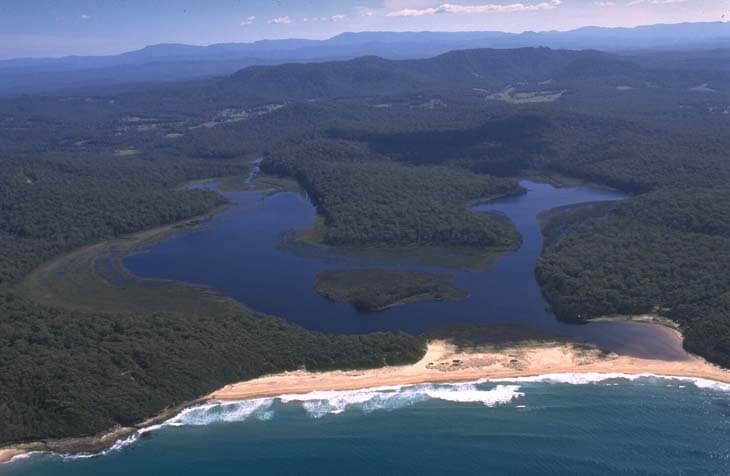Meroo Lake estuary is classed as a back-dune lagoon and has an intermittently closed entrance. Located on the south coast of New South Wales, it enters the ocean just north of the boundary of Batemans Marine Park.
The lake is listed in the National Directory of Important Australian Wetlands because of its high biodiversity and the large number of native mammals and frogs that it supports.
Water quality report card
As part of our water quality monitoring program we assess the water quality and ecosystem health of an estuary using a range of relevant indicators. We sample a subset of the estuaries between Wollongong and the Victorian border every 3 years. The most recent sampling in Meroo Lake was completed over the 2020–21 summer, when 2 sites were sampled on a monthly basis.
This report card represents 2 water quality indicators that we routinely measure: the amount of algae present and water clarity. Low levels of these 2 indicators equate with good water quality.
Algae
Water clarity
Overall grade
This report card shows the condition of the estuary was good with:
- algae abundance graded good (B)
- water clarity graded excellent (A)
- overall estuary health graded good (B).
Grades for algae, water clarity and overall are represented as:
- A – excellent
- B – good
- C – fair
- D – poor
- E – very poor.
Go to estuary report cards to find out what each grade means, read our sampling, data analysis and reporting protocols, and find out how we calculate these grades.
We have monitored water quality in Meroo Lake since 2008. This table shows the water quality grades for this estuary over that time.
| Year | Algae | Water clarity | Overall grade |
|---|---|---|---|
| 2009-10 | A | A | A |
| 2010-11 | B | A | A |
| 2011-12 | B | A | B |
| 2012-13 | B | A | B |
| 2013-14 | A | B | B |
| 2014-15 | B | A | A |
| 2015-16 | C | A | B |
| 2016-17 | C | C | C |
| 2017-18 | A | A | A |
| 2019-20 | B | A | A |
Physical characteristics
| Estuary type | Back-dune lagoon |
|---|---|
| Latitude (ºS) | –35.48 |
| Longitude (ºE) | 150.39 |
| Catchment area (km2) | 19.3 |
| Estuary area (km2) | 1.4 |
| Estuary volume (ML) | 1296.8 |
| Average depth (m) | 0.9 |
Notes: km2 = square kilometres; m = metres; ML = megalitres.
Water depth and survey data
Bathymetric and coastal topography data for this estuary are available in our data portal.
Land use
The catchment of Meroo Lake is moderately disturbed, with 20% cleared for grazing around the locality of Termeil. Over 65% of the catchment is forested and lies within Meroo National Park, and higher up in the catchment on Forestry Corporation land.
National and marine park
- Meroo Lake sits entirely within Meroo National Park.
- There is no marine park associated with Meroo Lake.
Citizen science
- The South Coast Shorebird Recovery Program provides the opportunity for people to get involved in the protection and recovery of shore birds.
- The Budawang Coast Nature Map is an online data platform the community can use to record and identify biodiversity. Data collected is used to map the distribution of native plant and animal species from Moruya up almost to Kiama.
Community involvement
- The Shoalhaven Landcare Association represents a range of volunteer groups working in and around Meroo Lake.

Aerial view of Meroo Lake estuary.
Local government management
Local councils manage estuaries within their area unless the estuary is attached to a marine park.
Shoalhaven City Council manages this estuary.
Threatened species
A number of threatened species can be found in Meroo Lake and the surrounding habitat, such as the green and golden bell frog and the hooded plover.
Learn more about the biodiversity in our estuaries.